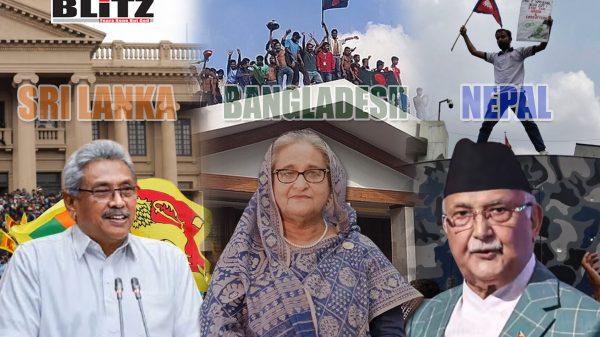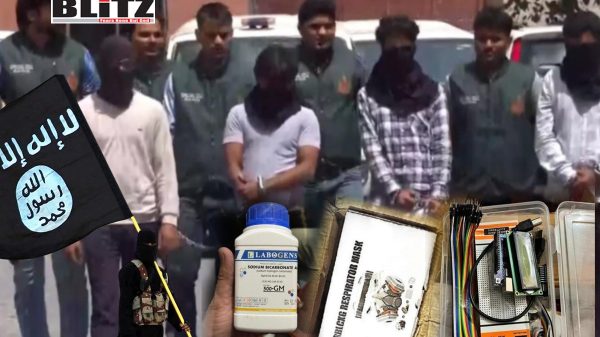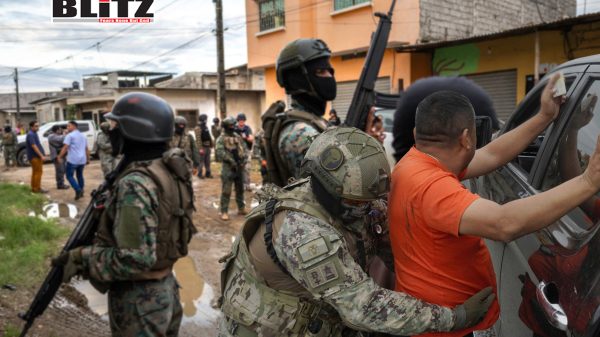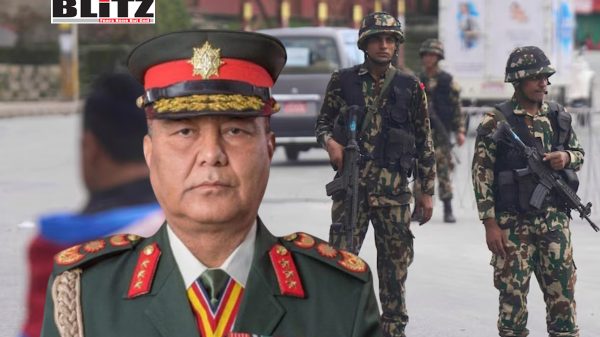Bangladesh, Sri Lanka, Nepal: A pattern of foreign-backed chaos in South Asia
- Update Time : Saturday, September 13, 2025

South Asia today is facing an unprecedented crisis of political stability and national sovereignty. One after another, countries in the region are falling prey to engineered uprisings that begin with small-scale protests but spiral into violent regime-change operations. From Colombo to Dhaka and now Kathmandu, the pattern is strikingly similar: grievances are magnified, mobs mobilized, governments delegitimized, and chaos unleashed — leaving fertile ground for external forces and radical groups to step in. What is unfolding resembles not just a new Cold War but a neo-colonial strategy — a “Neo-East India Company” operating under the guise of democracy promotion and people’s movements. While these movements appear organic, closer scrutiny reveals strikingly similar patterns — youth mobilization through social media, magnification of grievances, rapid escalation into violence, and ultimately, the ouster of governments.
From Sri Lanka’s Aragalaya in 2022 to Bangladesh’s “July Revolution” in 2024 and now Nepal’s Gen Z uprising in 2025, the story has been repeating with alarming precision. Each upheaval leaves chaos in its wake, weakening state institutions, crippling economies, and creating fertile ground for extremist groups. The parallels with the East India Company’s colonial strategy are unmistakable. The difference is that this modern-day “Neo-East India Company” operates not through armies and trade monopolies but through NGOs, media campaigns, digital warfare, and external political networks.
The ultimate objective is not democracy or reform but destabilization — creating fractured states that are pliable to foreign interests.
Sri Lanka: The first domino
Sri Lanka’s crisis in 2022 was presented to the world as a spontaneous revolt against corruption and economic collapse. Indeed, the hardships were real: shortages of food and fuel, skyrocketing inflation, and crippling power cuts. But the speed with which discontent was weaponized raised questions.
The Aragalaya protests were youth-driven, fueled by hashtags like #GoHomeGota, and coordinated through encrypted social media channels. Activists were supplied with logistics, amplification by global media outlets, and moral endorsement from Western NGOs. Soon, protesters occupied Colombo’s presidential palace, forcing President Gotabaya Rajapaksa to flee.
Although Ranil Wickremesinghe later stabilized the country, the political landscape had been irreparably weakened. What was framed as a democratic movement was in fact an externally nudged regime change. Two years on, Sri Lanka remains vulnerable, as networks that engineered the uprising continue working through local civil society groups.
Bangladesh: From quota protest to Islamist takeover
In July 2024, a seemingly minor protest over government job quotas in Bangladesh spiraled into a full-scale uprising. Within weeks, Prime Minister Sheikh Hasina was forced into exile, and Nobel laureate Muhammad Yunus — closely tied to the Clintons, Soros, and other Western elites — emerged as head of an “interim” regime.
What followed was catastrophic. Instead of stabilizing the country, Yunus empowered Islamist forces. Jamaat-e-Islami, long banned for its role in Bangladesh’s 1971 genocide and notorious for its anti-India stance, reemerged as a key player. Islami Andolan Bangladesh, led by the so-called “Chormonai Pir”, openly declared its ambition to turn Bangladesh into a Taliban-style emirate.
Yunus had initially promised elections within a year, but clear signs point to his intent to postpone them indefinitely. His strategy appears aimed at dismantling established political parties — the Awami League, BNP, and Jatiyo Party — to pave the way for Islamist dominance. Already, mob violence, arson, extortion, and targeted killings have become commonplace, eroding Bangladesh’s once-promising economic trajectory.
For India, this shift is alarming. A destabilized, Islamist-controlled Bangladesh would not only undermine regional security but also threaten India’s northeast, which shares a porous border with Bangladesh.
Nepal: Gen Z uprising turns violent
September 2025 saw Nepal descend into chaos. Triggered by the government’s decision to block 26 unregistered social media platforms, including Facebook, YouTube, and Instagram, protests rapidly escalated. Viral TikTok videos contrasting the struggles of ordinary Nepalis with the extravagant lifestyles of political elites’ children — dubbed “Nepo Kids” — ignited mass outrage.
CNN described it as a “Gen Z-led social media movement”, but what unfolded was far from peaceful. Kathmandu witnessed arson, looting, rapes, and lynchings. The Hilton Hotel and Kantipur Publications were set ablaze, and the Parliament building — a symbol of Nepalese democracy — was reduced to ashes. Shockingly, many rioters were young people in school uniforms carrying backpacks, eerily resembling the protesters in Sri Lanka and Bangladesh.
Observers reported that many rioters behaved as if drugged, evoking comparisons with Hitler’s indoctrinated Nazi youth or the brutalities of Hamas savages. Nepal’s thriving tourism sector now lies in ruins, with global images of violence discouraging foreigners from visiting. Worse, jihadist groups such as Al Qaeda and Lashkar-e-Taiba, long rumored to operate training camps in remote Himalayan areas, could exploit the chaos to kidnap tourists and extort ransoms.
Nepal’s fragile democracy has effectively been paralyzed. With its parliament destroyed and political leadership delegitimized, the country faces years of instability and economic decline.
The colonial parallel: A neo-East India Company
The recurring pattern in Sri Lanka, Bangladesh, and Nepal is too systematic to be dismissed as coincidence. Each case demonstrates a four-step playbook:
- Youth mobilization via social media — grievances amplified, often through Western platforms, to mobilize discontent.
- Delegitimization of governments — leaders branded corrupt, authoritarian, or out of touch, regardless of context.
- Escalation into violence — rapid transformation of protests into riots, often involving arson, vandalism, and mob attacks.
- External exploitation — Western NGOs, media, and political actors step in to endorse or guide the uprising.
This mirrors the East India Company’s colonial strategy of destabilizing local rulers before asserting control. The difference is that today’s objective is not formal colonization but geopolitical leverage: weakening sovereign states so they remain dependent and pliable.
India’s strategic dilemma
For India, these developments are deeply concerning. Encircled by instability, New Delhi faces a nightmare scenario:
- Sri Lanka: Strategic maritime hub in the Indian Ocean, vulnerable to renewed unrest and Chinese influence.
- Bangladesh: A crucial neighbor with a 4,000-km border, sliding into Islamist radicalization.
- Nepal: A buffer state between India and China, now in chaos and vulnerable to jihadist exploitation.
India is caught in a double bind. On one hand, it must prevent Islamist networks from exploiting weak neighbors. On the other, it must counter China’s growing influence, particularly through its Belt and Road Initiative (BRI). Beijing has invested heavily in Sri Lanka’s Hambantota Port, Bangladesh’s infrastructure, and Nepal’s hydropower projects. A destabilized South Asia allows China to expand its footprint while India struggles with security crises.
Pakistan, meanwhile, sees opportunity. Through its intelligence agency ISI, it has long sought to exploit Islamist networks in Bangladesh and Nepal to undermine India. Reports suggest ISI-trained operatives are already using the chaos in Nepal as cover for infiltration.
The alignment of China and Pakistan in exploiting South Asian instability is a strategic nightmare for India. Unless New Delhi responds proactively, it risks being surrounded by hostile or unstable states, undermining its regional leadership.
Western media and the “Color Revolution” template
Another common factor across these crises is the role of Western media. Outlets such as CNN, BBC, and The New York Times have repeatedly framed uprisings as democratic revolutions, glossing over the violence and chaos. Social media platforms, largely Western-owned, serve as both the mobilization tool and the amplifier.
This fits the “color revolution” template first seen in Eastern Europe and the Middle East. Just as the Arab Spring toppled governments but left Libya, Syria, and Yemen in ruins, the South Asian uprisings leave behind broken states vulnerable to extremism. Democracy is the slogan, but destabilization is the outcome.
Future flashpoints: Who’s next?
If the pattern continues, other South Asian states could be next.
Maldives: Already struggling with Islamist radicalization and political instability, it is a ripe target for social-media-driven unrest.
Bhutan: Though often seen as stable, its youth unemployment and dependence on India make it vulnerable to discontent campaigns.
Myanmar: Already in civil war, external actors could exploit the conflict further to destabilize India’s northeast.
Each of these states, if destabilized, would add to India’s security burden and further fracture the region.
South Asia at the crossroads
From Colombo’s Aragalaya to Dhaka’s “July Revolution” to Kathmandu’s Gen Z uprising, South Asia is caught in a cycle of engineered instability. These are not organic movements for democracy but coordinated regime-change operations that weaken states, empower extremists, and serve external interests.
The Neo-East India Company is back — not with gunboats and trade monopolies but with NGOs, digital campaigns, and media narratives. Its goal is not liberation but subjugation through chaos.
For South Asia, and especially for India, the warning is clear. Unless these patterns are recognized and countered, the region risks becoming a theater of perpetual unrest, vulnerable to Islamist extremism, Chinese opportunism, and Western manipulation.
The fate of Sri Lanka, Bangladesh, and Nepal should serve as urgent lessons. Regime change engineered from abroad does not deliver democracy. It delivers devastation. Only vigilance, strong institutions, and regional solidarity can prevent South Asia from being recolonized under the banner of freedom.











